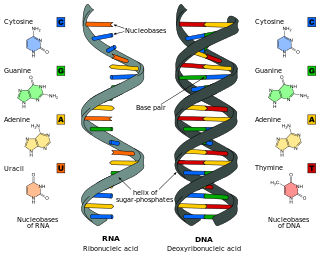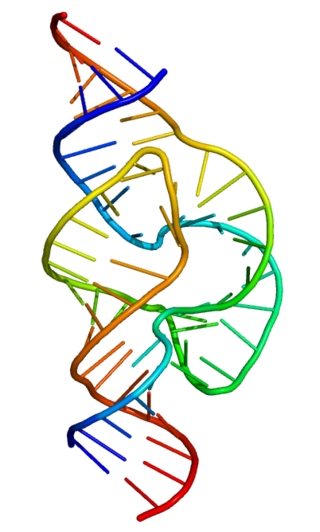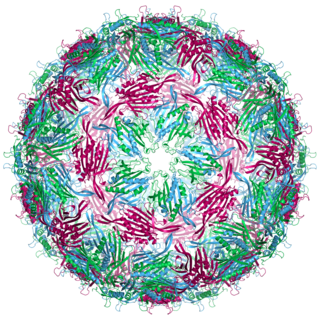Related Research Articles

Deoxyribonucleic acid is a polymer composed of two polynucleotide chains that coil around each other to form a double helix. The polymer carries genetic instructions for the development, functioning, growth and reproduction of all known organisms and many viruses. DNA and ribonucleic acid (RNA) are nucleic acids. Alongside proteins, lipids and complex carbohydrates (polysaccharides), nucleic acids are one of the four major types of macromolecules that are essential for all known forms of life.

The RNA world is a hypothetical stage in the evolutionary history of life on Earth in which self-replicating RNA molecules proliferated before the evolution of DNA and proteins. The term also refers to the hypothesis that posits the existence of this stage.

Nucleotide bases are nitrogen-containing biological compounds that form nucleosides, which, in turn, are components of nucleotides, with all of these monomers constituting the basic building blocks of nucleic acids. The ability of nucleobases to form base pairs and to stack one upon another leads directly to long-chain helical structures such as ribonucleic acid (RNA) and deoxyribonucleic acid (DNA). Five nucleobases—adenine (A), cytosine (C), guanine (G), thymine (T), and uracil (U)—are called primary or canonical. They function as the fundamental units of the genetic code, with the bases A, G, C, and T being found in DNA while A, G, C, and U are found in RNA. Thymine and uracil are distinguished by merely the presence or absence of a methyl group on the fifth carbon (C5) of these heterocyclic six-membered rings. In addition, some viruses have aminoadenine (Z) instead of adenine. It differs in having an extra amine group, creating a more stable bond to thymine.

Ribozymes are RNA molecules that have the ability to catalyze specific biochemical reactions, including RNA splicing in gene expression, similar to the action of protein enzymes. The 1982 discovery of ribozymes demonstrated that RNA can be both genetic material and a biological catalyst, and contributed to the RNA world hypothesis, which suggests that RNA may have been important in the evolution of prebiotic self-replicating systems.
DNA primase is an enzyme involved in the replication of DNA and is a type of RNA polymerase. Primase catalyzes the synthesis of a short RNA segment called a primer complementary to a ssDNA template. After this elongation, the RNA piece is removed by a 5' to 3' exonuclease and refilled with DNA.
In molecular biology and biochemistry, processivity is an enzyme's ability to catalyze "consecutive reactions without releasing its substrate".

Leslie Eleazer Orgel FRS was a British chemist. He is known for his theories on the origin of life.
The Pribnow box is a sequence of TATAAT of six nucleotides that is an essential part of a promoter site on DNA for transcription to occur in bacteria. It is an idealized or consensus sequence—that is, it shows the most frequently occurring base at each position in many promoters analyzed; individual promoters often vary from the consensus at one or more positions. It is also commonly called the -10 sequence or element, because it is centered roughly ten base pairs upstream from the site of initiation of transcription.

RNA-dependent RNA polymerase (RdRp) or RNA replicase is an enzyme that catalyzes the replication of RNA from an RNA template. Specifically, it catalyzes synthesis of the RNA strand complementary to a given RNA template. This is in contrast to typical DNA-dependent RNA polymerases, which all organisms use to catalyze the transcription of RNA from a DNA template.

Bacteriophage MS2, commonly called MS2, is an icosahedral, positive-sense single-stranded RNA virus that infects the bacterium Escherichia coli and other members of the Enterobacteriaceae. MS2 is a member of a family of closely related bacterial viruses that includes bacteriophage f2, bacteriophage Qβ, R17, and GA.

T7 DNA polymerase is an enzyme used during the DNA replication of the T7 bacteriophage. During this process, the DNA polymerase “reads” existing DNA strands and creates two new strands that match the existing ones. The T7 DNA polymerase requires a host factor, E. coli thioredoxin, in order to carry out its function. This helps stabilize the binding of the necessary protein to the primer-template to improve processivity by more than 100-fold, which is a feature unique to this enzyme. It is a member of the Family A DNA polymerases, which include E. coli DNA polymerase I and Taq DNA polymerase.
EF-Ts is one of the prokaryotic elongation factors. It is found in human mitochondria as TSFM. It is similar to eukaryotic EF-1B.
The term proofreading is used in genetics to refer to the error-correcting processes, first proposed by John Hopfield and Jacques Ninio, involved in DNA replication, immune system specificity, and enzyme-substrate recognition among many other processes that require enhanced specificity. The proofreading mechanisms of Hopfield and Ninio are non-equilibrium active processes that consume ATP to enhance specificity of various biochemical reactions.

Bacteriophage Qbeta, commonly referred to as Qbeta or Qβ, is a species consisting of several strains of positive-strand RNA virus which infects bacteria that have F-pili, most commonly Escherichia coli. Its linear genome is packaged into an icosahedral capsid with a diameter of 28 nm. Bacteriophage Qβ enters its host cell after binding to the side of the F-pilus.

In chemistry, a hypercycle is an abstract model of organization of self-replicating molecules connected in a cyclic, autocatalytic manner. It was introduced in an ordinary differential equation (ODE) form by the Nobel Prize in Chemistry winner Manfred Eigen in 1971 and subsequently further extended in collaboration with Peter Schuster. It was proposed as a solution to the error threshold problem encountered during modelling of replicative molecules that hypothetically existed on the primordial Earth. As such, it explained how life on Earth could have begun using only relatively short genetic sequences, which in theory were too short to store all essential information. The hypercycle is a special case of the replicator equation. The most important properties of hypercycles are autocatalytic growth competition between cycles, once-for-ever selective behaviour, utilization of small selective advantage, rapid evolvability, increased information capacity, and selection against parasitic branches.
Φ29 DNA polymerase is an enzyme from the bacteriophage Φ29. It is being increasingly used in molecular biology for multiple displacement DNA amplification procedures, and has a number of features that make it particularly suitable for this application. It was discovered and characterized by Spanish scientists Luis Blanco and Margarita Salas.
Numerous key discoveries in biology have emerged from studies of RNA, including seminal work in the fields of biochemistry, genetics, microbiology, molecular biology, molecular evolution, and structural biology. As of 2010, 30 scientists have been awarded Nobel Prizes for experimental work that includes studies of RNA. Specific discoveries of high biological significance are discussed in this article.
The history of genetics can be represented on a timeline of events from the earliest work in the 1850s, to the DNA era starting in the 1940s, and the genomics era beginning in the 1970s.

Xeno nucleic acids (XNA) are synthetic nucleic acid analogues that have a different backbone from the ribose and deoxyribose found in the nucleic acids of naturally occurring RNA and DNA.
Charles Clifton Richardson is an American biochemist and professor at Harvard University. Richardson received his undergraduate education at Duke University, where he majored in medicine. He received his M.D. at Duke Medical School in 1960. Richardson works as a professor at Harvard Medical School, and he served as editor/associate editor of the Annual Review of Biochemistry from 1972 to 2003. Richardson received the American Chemical Society Award in Biological Chemistry in 1968, as well as numerous other accolades.
References
- ↑ Spiegelman, S., Haruna, I., Holland, I.B., Beaudreau, G. & Mills, D. (1965). "The Synthesis of a Self-propagating and Infectious Nucleic Acid with a Purified Enzyme". Proc. Natl. Acad. Sci. USA. 54 (3): 919–927. Bibcode:1965PNAS...54..919S. doi: 10.1073/pnas.54.3.919 . PMC 219765 . PMID 5217468.
{{cite journal}}: CS1 maint: multiple names: authors list (link) - ↑ Mills, D. R., R. L. Peterson, Sol Spiegelman (1967). "An extracellular Darwinian experiment with a self-duplicating nucleic acid molecule". Proceedings of the National Academy of Sciences . 58 (1): 217–24. Bibcode:1967PNAS...58..217M. doi: 10.1073/pnas.58.1.217 . PMC 335620 . PMID 5231602.
{{cite journal}}: CS1 maint: multiple names: authors list (link) - ↑ Kacian,D.L., D.R. Mills, F.R. Kramer, S. Spiegelman (1972). "A Replicating RNA Molecule Suitable for a Detailed Analysis of Extracellular Evolution and Replication". Proceedings of the National Academy of Sciences . 69 (10): 3038–3042. Bibcode:1972PNAS...69.3038K. doi: 10.1073/pnas.69.10.3038 . PMC 389702 . PMID 4507621.
{{cite journal}}: CS1 maint: multiple names: authors list (link) - ↑ Sumper, M; R. Luce (1975). "Evidence for de novo production of self-replicating and environmentally adapted RNA structures by bacteriophage Qbeta replicase" (PDF). Proceedings of the National Academy of Sciences . 72 (1): 162–166. Bibcode:1975PNAS...72..162S. doi: 10.1073/pnas.72.1.162 . PMC 432262 . PMID 1054493.
- ↑ Oehlenschläger, Frank; Eigen, Manfred (December 1997). "30 Years Later – a New Approach to Sol Spiegelman's and Leslie Orgel's in vitro Evolutionary Studies Dedicated to Leslie Orgel on the occasion of his 70th birthday". Origins of Life and Evolution of Biospheres . 27 (5–6): 437–457. Bibcode:1997OLEB...27..437O. doi:10.1023/A:1006501326129. PMID 9394469. S2CID 26717033.
- ↑ Dawkins, Richard; Wong, Yan (2016). The Ancestor's Tale. Houghton Mifflin Harcourt. ISBN 978-0544859937.